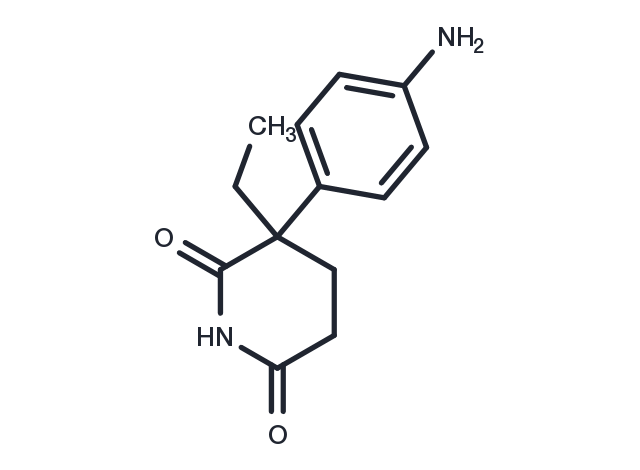Powder: -20°C for 3 years | In solvent: -80°C for 1 year


Aminoglutethimide (BA-16038), an aromatase inhibitor, is used in the therapy of advanced BREAST Y.

| Pack Size | Availability | Price/USD | Quantity |
|---|---|---|---|
| 25 mg | In stock | $ 54.00 | |
| 50 mg | In stock | $ 82.00 | |
| 100 mg | In stock | $ 142.00 | |
| 200 mg | In stock | $ 181.00 | |
| 1 mL * 10 mM (in DMSO) | In stock | $ 50.00 |



| Description | Aminoglutethimide (BA-16038), an aromatase inhibitor, is used in the therapy of advanced BREAST Y. |
| Targets&IC50 | Aromatase:10 μM |
| In vivo | Aminoglutethimide accelerates its own metabolism from a basal value of 2.6±0.3 (S.E.) liters/24 hours to 5.3±1.4 liters/24 hours after 1 to 2 weeks of Aminoglutethimide administration, and markedly accelerates the metabolism of the synthetic glucocorticoid and dexamethasone, from basal values of 145±26.6 liters/24 hours to 568±127 liters/24 hours (p < 0.02) after 2 weeks of Aminoglutethimide administration. [3] Aminoglutethimide (150 mg/kg) abolishes the induction of ornithine decarboxylase (ODC) and almost depletes the gonads and plasma of progesterone or testosterone elicited by human chorionic gonadotropin (hCG) in the ovary of adult female mice and the testis of immature male mice, which is related to an inhibition of cAMP-dependent protein kinase (IC50 287 μM) rather than blockade of the steroidogenic pathway. [4] |
| Kinase Assay | Concentration–response and kinetic studies: The microsomal protein (30 μg), [1β-3H]androstenedione (6.6 × 105 dpm) and NADPH (270 μM) are used for the concentration–response experiment with an incubation time of 20 minutes. The Aminoglutethimide is initially tested at 10 μM and 100 μM concentrations, followed by a full concentration–response study with at least 8 concentrations ranging from 0.01 μM to 160 μM. For the initial velocity study the concentration of [1β-3H]androstenedione is varied from 7.5 to 100 nM and the incubation time is set to 5 minutes. The tritiated water formed during the conversion of the tritiated substrate, [1β-3H]androstenedione, to estrone is quantified by liquid scintillation counting. Each assay is performed three times in duplicate and the results are treated by nonlinear regression analysis allowing the determination of the half-maximal inhibitory concentration (IC50). |
| Cell Research | The NCI-h295 tumor cell line is maintained in RPMI 1640 medium supplemented with transferrin (0.1 mg/mL), insulin (5 μg/mL), selenium (5.2 μg/mL) and 2% FCS. The cells are incubated for 48 hours with Aminoglutethimide (3, 30, 300 μM). Then cells are examined by trypan blue staining for cell viability, counted with a coulter counter. For the assessment of ACTH-R mRNA, cells are harvested, and total RNA is extracted, electrophoresed, blotted and hybridized with a human ACTH-R cDNA probe.(Only for Reference) |
| Synonyms | DL-Aminoglutethimide, BA-16038, NSC-330915 |
| Molecular Weight | 232.28 |
| Formula | C13H16N2O2 |
| CAS No. | 125-84-8 |
Powder: -20°C for 3 years | In solvent: -80°C for 1 year
Ethanol: 7 mg/mL (30.13 mM)
DMSO: 16 mg/mL (68.9 mM)
You can also refer to dose conversion for different animals. More
bottom
Please see Inhibitor Handling Instructions for more frequently ask questions. Topics include: how to prepare stock solutions, how to store products, and cautions on cell-based assays & animal experiments, etc.
Aminoglutethimide 125-84-8 Endocrinology/Hormones Aromatase NSC330915 DL-Aminoglutethimide BA16038 inhibit BA 16038 NSC 330915 BA-16038 Inhibitor NSC-330915 inhibitor
